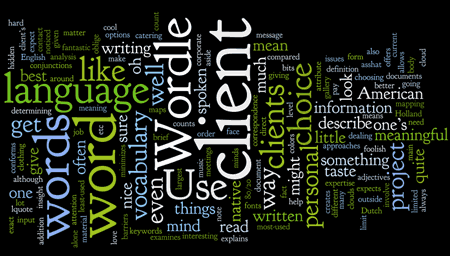When in direct contact with clients, there are many different things we can read in order to get information to help us do our job even better—which, let’s face it, is to give our clients what they want while catering to what they need, in a way which conforms to our own standards of quality. The information the client voluntarily provides is the primary source of input for a project, but things we can pick up on outside of the main message can be relevant as well:
- personal taste of the client
- personal taste of the spouse of the client (oh, yes, it’s true) or other stakeholders
- body language
- use of language and tone-of-voice (whether written or spoken)
- etc. (I’m sure you can think of quite a few)
Use of language
Use of language is an interesting one. I’m an American working in Holland, so when I write proposals in Dutch, I might not be choosing the very best words to describe what I mean because there’s always a limit to my vocabulary compared to that of a native speaker. Even within my native American English, I’m sure my vocabulary is quite limited (although I’d love to attribute that fact to
the 80/20 rule). But language barriers aside, when one’s vocabulary offers more than one word to describe something, the choice of word can say a lot about the way the person approaches a given subject. Choice of words, very much like choice of clothing or choice of music, can give tiny bits of insight into personal preference, corporate politics (in the form of resentment or rebellion), level of expertise on web-related issues and sometimes even hidden meaning.
This very simple process would involve determining which meaningful words a client uses, and how often they use them. By meaningful I mean giving little or no value to adjectives, conjunctions and the like. “The” is not going to tell us much.
How to do it
With the spoken word this is hard to do. You can’t get an exact count of specific words while talking to a client. And if you could, you’d look like an asshat. Personally, I tend to make mind maps during client meetings, which by definition means that I’m only writing down keywords in relation to each other. Mind mapping also minimizes writing time, which allows me to pay more attention.
When you get written material from a client, like an RFP or a project brief, there’s a cool way to do it: Wordle. Wordle is a fantastic little tool which examines a piece of text, counts the words and creates a treemap-like visualization of these words. The most-used word is largest, while the least-used is smallest. And with options for colors, fonts and placement, Wordle word clouds look nice as well.

Play around
Try it out. Take a document in which your client explains what she wants or expects of your current project (or any correspondence, for that matter) and throw it into Wordle. See if it tells you something you hadn’t noticed by simply reading. Oh: Don’t save your client’s stuff in the Wordle gallery. Thank you.
Please note that in dealing with clients it would be foolish to rely on word analysis alone, but it could be a nice addition to one’s toolbox. Since clients often expect us to read their minds, we might as well oblige as best we can.